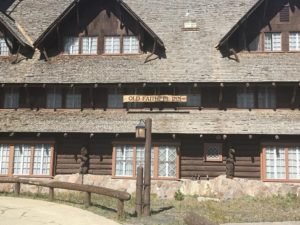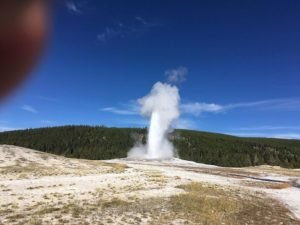The historic Old Faithful Inn is a must stop for anyone visiting Yellowstone National Park located in the northwest part of the state of Wyoming.

The Old Faithful Inn was constructed during the winter of 1903-04, within Yellowstone National Park. The structure was built using materials from within the park and cost over $165,000 to complete. The Old Faithful Inn was designed by Robert C. Reamer. The inn was constructed in three phases. Those being in the years of 1903, 1913, and 1927.
The Old Faithful Inn is a National Historic Landmark and is one of the few remaining log hotels in the United States.
As a national historic landmark,Old Faithful Inn is the most popular lodging facility within Yellowstone. The interior lobby area is large and unique to say the least. The inn combines rugged materials and organic motifs that expresses both frontier sensibilities and elegance.The towering lobby features a very large stone fireplace and a hand crafted clock made of copper.

The Old Faithful Historic District is historically important because of its rustic timber architecture and its role in the development of concessions to accommodate growing tourism in the early 1900s. The Old Faithful Lodge which is located near the Inn had several changes to it’s original design and what is seen now is where the last construction was completed in 1928. The design for the Old Faithful Historic District was done by Gilbert Stanley Underwood, a famous architect.
The historic district consists of the Old Faithful Inn, Old Faithful Lodge, three stores, two service stations, five dormitories, ten support buildings as well as the guest cabins behind the Old Faithful Lodge and the Snow Lodge. The Snow Lodge with it’s large timber construction was completed in 1999 and is the newest of the park’s full service hotels. The Snow Lodge is open from about mid December to the first week of March and then from about the end of April to the end of October. Check with the lodge for exact dates.
The Old Faithful Geyser

The very popular Old faithful Geyser in Yellowstone National Park is situated directly across from the Old Faithful Inn.
Approximate times that the geyser erupts is posted on a sign outside the Inn. The second floor of the Inn has a deck on the second floor where visitors can relax with refreshments and watch Old Faithful Geyser Erupt.
You’ll also find a raised walking trail outside the Old faithful Inn and adjacent to Old Faithful Geyser where you’ll see various hot springs and other smaller geyser eruptions on your trek. The geology of the area is amazing and is found in only a few other places on earth.
Yellowstone Hiking
Yellowstone National Park has some 1,100 miles of hiking trails, Yellowstone’s trails can be enjoyed by day hikers of all abilities. Some of these are short boardwalk trails to popular geothermal attractions. There are plenty of trails also in Yellowstone’s back country. Explore past the developed areas and you’ll see wondrous and beautiful mountainous, landscape that offers various trails for all hiking skill levels. Many types of wildlife including grizzly bears reside in Yellowstone and it is highly recommended that hikers bring along bear spray for protection. Bear spray is available for purchase in many stores within the park.
Related Trips Into History articles are found on the links below…
Visit Rocky Mountain National Park
Yellowstone Fishing
 Another very popular activity in Yellowstone National Park is fishing. Yellowstone has a long tradition of fly fishing. This sport has been popular their for over one hundred years. Fishermen have the choice of Lake Yellowstone which is a deep lake with abundant trout and other smaller lakes.
Another very popular activity in Yellowstone National Park is fishing. Yellowstone has a long tradition of fly fishing. This sport has been popular their for over one hundred years. Fishermen have the choice of Lake Yellowstone which is a deep lake with abundant trout and other smaller lakes.
August is the best time for lake fishing in the Park. Also a large number of rivers. Included in these rivers is the Madison, Firehole, Yellowstone, Gardiner and Slough. When in the area of Yellowstone be sure to check out the fishing stores and guide services.
Vintage Yellowstone National Park Retro Travel Gift Pullover Hoodie
Trekking The National Parks Water Bottle with 63 Waterproof Stickers & 3 Lids (Straw, Spout, & Chug) | 32 Oz Insulated Wide Mouth Stainless Steel Bottle for Camping & Hiking | BPA-Free and Leak-Proof
Trips Into History searches for various products that we feel the traveling and historic enthusiast community in general can benefit from. As an Amazon Affiliate, Trips Into History earns a commission from qualifying purchases through our links, at no cost to you.
(Article and photos copyright Trips Into History)

